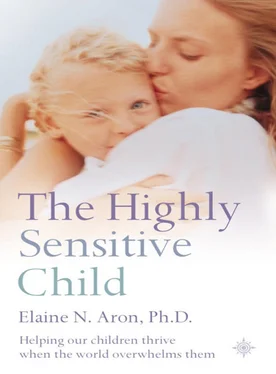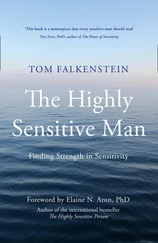In another animal experiment, looking at the “personality types” of pumpkinseed sunfish, a pond was filled with traps. According to the researchers, the majority of fish were “bold” and behaved “normally” by going into the traps, while the minority, the “shy” fish, escaped the traps. (What I want to know is why the two types weren’t called the stupid and the smart sunfish? Or at least the nonsensitive and sensitive!)
HOW THE HUMAN SPECIES WILL BENEFIT FROM YOUR HSC
In human groups there are enormous advantages to having a large minority who reflect before acting. They notice potential danger sooner; the others can then rush out to take care of it (and even enjoy the excitement of it all). The sensitive ones think carefully about consequences, too, and often insist that the others pause, see what may happen, and develop the best strategy. Clearly the two work best in combination.
Traditionally, sensitive people have been the scientists, counselors, theologians, historians, lawyers, doctors, nurses, teachers, and artists (for example, at one time sensitive people naturally became their town’s schoolmaster or -mistress, preacher, or family doctor). But, increasingly, sensitive persons are being nudged out of all these fields due to what seems to be a cycle that starts with the nonsensitive moving aggressively into decision-making roles, where they, quite naturally due to their temperaments, devalue cautious decision making, emphasize short-term profits or flashy results assertively presented over a quieter concern for consistent quality and long-term consequences, and do not need and so eliminate calm work environments and reasonable work schedules. Sensitive people are discounted, have less influence, suffer, or quit. Then the non-sensitive control the profession even more.
My description of this cycle is not meant as a complaint—merely an observation about a probable reason for these professions becoming more profit-oriented and less satisfactory in their results. In today’s world, too, if decision makers are not thinking enough about complexities and consequences, there is also danger as well as discomfort when there is an imbalance between the influence of the sensitive and nonsensitive. So it is critical for all of us that your HSC emerge from your home feeling confident and important, so he can share his gifts and have a solid influence on others.
Your Child Is Still Utterly Unique—Like Rhoda’s Three
Now that I have made a case for “sensitive” as the best label for this trait, let’s admit one problem with labels (there are others of course). It seems as though as soon as we give something a label, we think we know quite a bit about it, whether it is a camellia, a German shepherd, or an HSC. In fact, we still know very little about each individual camellia, German shepherd, or HSC.
As I interviewed parents and children specifically for this book, I was stunned by the uniqueness of each HSC, even more than in adults. It made me agree yet again with Margaret Mead, who said that children are born with a great variety of traits, like the many hues of a palette, but the culture encourages only certain ones. The others are ignored or flatly discouraged, so that by adulthood there is less variety.
In childhood, however, there is a vast palette, even among HSCs. Consider Rhoda, a highly sensitive person with three older HSCs—ages twenty-two, twenty, and sixteen. As children, they were all more aware of stimuli than other kids. They all needed more rest and “down time” than their peers. People told all three of them at various times that they were “overreacting” and “too sensitive.” Each found some form of artistic endeavor to express their intense awareness.
But such different children! Ann, the oldest, is a photographer. She likes fresh experiences—she rides motorcycles, jumps out of airplanes. Andrew, the middle child, is conservative, particular, and “fussy.” He is a visual artist. His work is very detailed and careful. From birth he was always the most sensitive to sound and to scents.
All three are intensely emotional, but Ann and Andrew do not let it show. Tina, the youngest, has always been more dramatic and expressive. As a child she threw tantrums. As a teenager she has dark depressions. Her art form is poetry—something she can read out loud. Her colds are more likely to become bronchitis or even pneumonia, something that takes her to the doctor’s office.
WHY DO EVEN HSCS VARY SO MUCH?
One reason for the variation among HSCs is that temperament traits seem to be caused by several genes, each having small, cumulative effects. Thus each different flavor of sensitivity—sensitivity to the subtle, the overwhelming, the new, the emotional, the social, or the physical and nonsocial—may be caused by a different gene. Yet there is still something common to these different sensitivities and they may tend to be inherited together. (If the underlying trait was not one trait, my questionnaire would have uncovered several different “factors,” but there was only one.)
Here are more examples of the range of HSCs. Yes, Rhoda’s youngest, Tina, had tantrums, as do many HSCs when young and overstimulated. But in this book you will also meet Alice, who is three and has never had a tantrum. She is strong-willed and opinionated, but when she wants something, she says it in a way that is almost uncanny in its maturity.
You will meet Walt, seven, who hates sports (but loves chess); Randall, nine, who will only play baseball, and only if his mother coaches the team; and Chuck, also nine, who will play any sport and be good at it. He climbs high and loves to ski, but he knows his terrain and his limits. (On a recent skiing trip, Chuck was caught at the top in a blizzard. He cried from the stress of it, but insisted on going down anyway.)
Chuck is an indifferent student; Walt and Randall are doing great academically. Catherine has been advanced almost every grade, starting with a move from preschool to kindergarten. And Maria was her high school’s valedictorian and graduated summa cum laude in chemistry from Harvard.
You already read about Tina being an extrovert. Chuck is also extroverted, popular, already discovered by the girls. In contrast, Randall has limited friendships, mainly because he does not like to go to other homes—he dislikes the unfamiliar family members, food, and routines.
Sometimes the quality that parents notice most is their child’s emotional sensitivity. You’ll meet River, a teenager so aware of others’ emotions that he begged his mother to take in a homeless person he found in the park. (His mother decided to let the man stay until her son realized the problems with the situation and found another solution, which he did after three months.)
Melanie, eight, is another HSC with emotional sensitivity. She cries if she feels embarrassed or if someone else is teased. Her sensitivity also extends to physical pain. Afraid of falling, she did not learn to ride a bike without training wheels until her sister, three years younger, learned. Her pride finally forced her to take the risk.
Walt is mostly sensitive to new situations and people. Consider Walt’s first experience with grass: He crawled to the edge of a blanket, continued onto the grass, and cried from the shock of it. His mother remembers that two years later his sister crawled to the edge of the blanket, felt the grass, and just kept going.
Larry, thirteen now, is mostly sensitive to sound, clothing, and foods. Until kindergarten he only wore sweatshirts and sweatpants. He could not bear the roughness of jeans. Like Walt, he also doesn’t like new situations—he refuses to go to camp or take long vacations.
Mitchell, five, seems to have all the characteristics of an HSC. He is sensitive to social novelty, so he’s really struggling with starting school. He does not like birthday parties and will not wear a costume at Halloween, not wanting everyone looking at him. He is slow verbally because he’s thinking so much before he speaks—he developed some stuttering after his older cousins came to visit because he had trouble speaking as quickly as they did. He has the physical sensitivity, too, so that he does not like foods that have been mixed or socks that rub. His mother cuts the tags from his clothing because they bother his neck and waist.
Читать дальше











